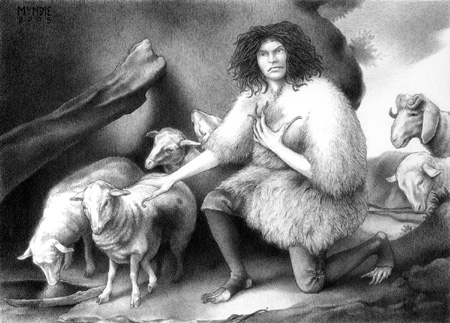The 'wild man' was a ubiquitous character in sideshow presentations. Often the mentally disabled
would be trotted out as a primitive form of man found in some deep jungle or remote mountain top.
They would be dressed in ragged clothing or furs, sometimes chained or caged, and
encouraged to act as the audience expected uncultured savages to behave.
By the late nineteenth century, the wild man persona shifted away from physical and mental anomalies to instead present
otherwise normal seeming characters (though with unsavory habits) who just happened to have been
raised by wolves. Shabbily dressed and smeared with grime, these unkempt characters would handle snakes and devour raw
meat as they had presumably learned to do in the hinterlands before being discovered by the
benevolent showman who rescued them and now presents them for the benefit of the public.
Although there were plenty of wild people around to act as ten-in-one platform fillers, most were
exhibited in pit shows. A pit show usually consists of an enclosure in the middle of the
tent which patrons can walk around and peer into. Down in the pit, the wild man or woman would go through their
routine. In time, the most successful of these acts developed the gross-out spectacle of the
glomming geek — that is, a performer who would bite the heads off of live snakes or chickens. This act
didn't require a great deal of skill, just the will to do it. More often than not, this job came to be
filled by itinerant down-and-out drunks or junkies in exchange for booze and board.
In the freakshow hierarchy the wild people were the lowest level attraction on the platform,
but a geek show was considered to be the absolute lowest of the low. Only the seediest promoters
would present geek shows. Many towns banned their exhibition entirely, which helped carnivals secure
their reputation for sleaziness. However, skilled performers have brought some respectability back to geeking.
Rather than decapitate an animal, a skilled geek will ingest seemingly inedible (and inanimate) objects such as nails, razor blades or light bulbs.
Although there were so many wild people working on the shows that they are now mostly anonymous, one
performer who left a mark was George Stall. In the 1890's, Stall was billed as "George, the Mexican
Wild Man" — Mexico being the most handily remote location at the time, apparently. Stall
appeared on stage with disheveled hair and exceedingly long, curling fingernails. His costume was a
curious affair of a fur tunic, knee britches, and abbreviated hosiery that allowed him to display his
overgrown toenails. Not really an outfit suited to life in the wild, but there you have it.
This drawing was inspired by a Charles Eisenmann photograph of Stall sitting on a cardboard rock that
put me in mind of Jusepe de Ribera's painting Jacob with His Flocks (1632, Madrid).



